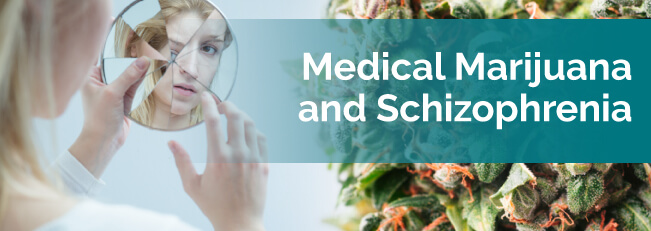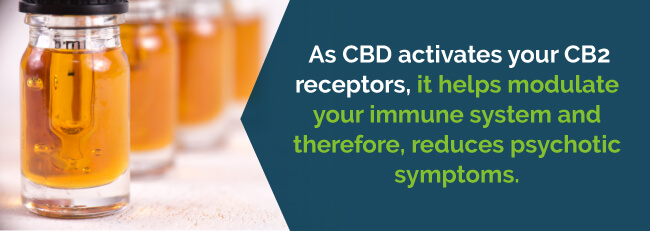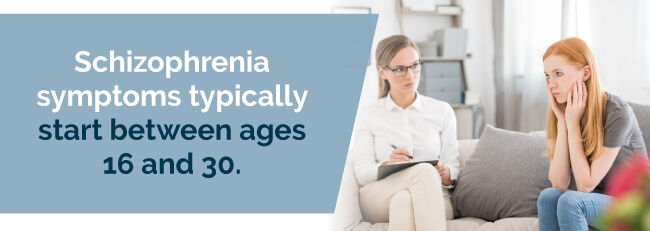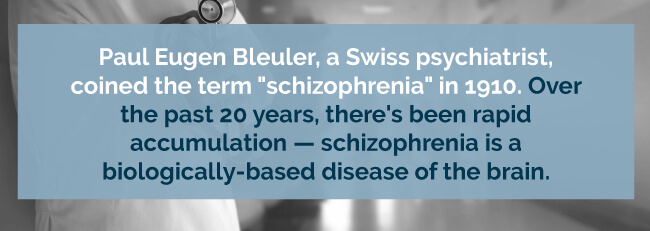
Although schizophrenia has no cure, the symptoms are manageable with supportive services and medication. However, the antipsychotic drugs today prescribed to treat the condition come with a whole array of side effects, from pacing, decreased muscle control and facial tics to physiological disorders like depression and anger.
Side effects like these limit patient compliance since many prefer the disorder’s symptoms over the treatments. So, more patients are turning to medical marijuana for schizophrenia to manage their condition without having to deal with the unwanted side effects of antipsychotic medications.
Researchers have found one of the primary active ingredients in marijuana, cannabidiol (CBD), offers antipsychotic effects since it activates CB2 receptors of your endocannabinoid system. According to studies, psychotic disorders link to alterations of your immune system involved in regulating your endocannabinoid system. As CBD activates your CB2 receptors, it helps modulate your immune system and therefore, reduces psychotic symptoms.

More recent studies show CBD offers schizophrenia relief by easing cognitive symptoms of the condition. The studies found regular CBD administration attenuates social withdrawal and cognitive deficits of people with schizophrenia.
Researchers also found CBD helps restore working memory and recognition and social behavior back to normal levels. The interesting part about this is that other medications weren’t able to treat some symptoms CBD could. And, CBD doesn’t alter your food intake or body weight, either, which are two common side effects of traditional antipsychotics.
Find A Doctor Find A Dispensary
Because marijuana has been touted as a cause of schizophrenia, research into the efficacy of medical marijuana as a treatment for the disorder is scarce. Other psychiatric medications are similar as they can help some and make things worse for others. But there is a stigma surrounding marijuana that doesn’t hinder the prescribing of these other medications.
Nonetheless, some researchers have ignored this stigma and conducted research, knowing a solution for schizophrenia is desperately needed. These studies do not include human trials, but are rather observations of the chemical changes wrought by medical marijuana.
Research suggests natural endocannabinoid levels are off in patients with schizophrenia. If this difference in endocannabinoid function differs between individuals with schizophrenia, it might explain why some react well to medical marijuana, and others react poorly.
Increasing endocannabinoids in an individual who is suffering from increased cannabinoids in the body could exacerbate whatever problems it’s causing. The opposite would be true if the person is suffering from decreased cannabinoid function.
Other research suggests the trick is locating the helpful components of medical marijuana concerning schizophrenia and targeting those that are not helpful. In this way, doctors can develop a drug that does not trigger psychotic symptoms in schizophrenics. If this is the reason some individuals are being helped by it and some are suffering, it could have everything to do with the strain of marijuana and what it has more and less of inside of it.
As mentioned above, medical marijuana can intensify symptoms of schizophrenia. However, it has several benefits as a medication most other anti-psychotic, antidepressant and anti-anxiety medications do not have.
According to one study, 90% of people who use marijuana do not become addicted. Furthermore, there is no known dosage of marijuana that can result in death. It is possible to overdose on most medications given to people schizophrenia. As the risk of suicide is relatively high among individuals with schizophrenia, giving them medications to help and are safe is both responsible and compassionate.
There is an array of medication available for schizophrenics. However, it takes diligent effort on the part of the sufferer and their medical team to find the right drug or mix of medications for the patient. Schizophrenics present with different symptoms and have different tolerances for different medications.
It’s common for individuals with schizophrenia to miss appointments because of their symptoms, cease taking their medications and be convinced they are not ill. This makes treatment difficult. People with schizophrenia need understanding support groups and compassionate health care providers who are careful to prescribe the drugs that work for the patient.
As you’ve read, schizophrenia can bring on many moods, psychological and behavioral symptoms including:
By using medical cannabis for schizophrenia, patients can address all of these symptoms.
CBD is not only just as effective as traditional antipsychotic medications, but it’s free of the common side effects antipsychotics produce. Antipsychotics can sometimes cause movement disorders that are occasionally permanent, and they also reduce the patient’s pleasure and motivation. Newer drugs often lead to an increase in diabetes and weight gain. This isn’t the case with CBD.
As CBD relieved patients’ symptoms during one study, it also increased their anandamide levels. Anandamide is a molecule that helps you cope with stress. It not only reduces stress, but it also relieves anxiety. It’s involved with stress-induced analgesia, so you don’t feel pain anymore while fleeing or fighting.

While schizophrenic patients may want to stay away from some types of the medical marijuana plant — like THC, which would stimulate an already excited mind — the CBD non-psychoactive compound is a potent antipsychotic. CBD also counteracts the effects of THC. Knowing this, you’ll want to look for strains low in THC and high in CBD.
The strains below all have less than one percent of THC content and between 15 to 20 percent CBD content.
If you plan on experimenting with schizophrenia and marijuana strains high in CBD, be sure to look for lab-tested products. Doing this will help you know what’s in your product so you can avoid too much THC. Below are potential strains to start with:
Although most people associate marijuana with smoking, there are many ways to reap the benefits of this medicine. One of the best ways to use cannabis for schizophrenia is with CBD oil. It doesn’t give you any physiological or psychological effects that leave you feeling high, and it’s low in THC. The oil is more potent with concentrated cannabinoid profiles, but you’ll find many oils with mostly CBD.
Since you can enjoy the benefits of CBD oil without having to smoke it, many seek the natural remedy for their children with serious illnesses. If you like smoking marijuana, you may want to try a vaporizer for whole-plant marijuana consumption.
You can use your CBD oil in:
You may already know medical cannabis is beneficial for patients with a whole range of health conditions — that includes schizophrenia. But first, you need to consult with a marijuana doctor to receive your recommendation.
At MarijuanaDoctors.com, we connect patients with reliable medical marijuana dispensaries and licensed, cannabis-friendly doctors to help them get the process started. Use our search engine to find a physician near you today!
Find A Doctor Find A Dispensary
Schizophrenia is a serious disorder affecting your brain. Those with the condition may think people are out to get them. Known as auditory hallucinations, they may hear voices that aren’t there. When people with schizophrenia talk, they sometimes don’t make any sense. Because of this, it’s hard for them to care for themselves or keep a job.
Schizophrenia symptoms typically start between ages 16 and 30, and men tend to see signs earlier than women. You usually don’t get the condition after you turn 45 years old. Schizophrenia has three primary types of symptoms:

There’s no known cause of schizophrenia. Your environment, brain chemistry and genes may be factors.
Medication may help control many symptoms of schizophrenia. You might have to try various medications to find the best ones for you. Your doctor will prescribe them for a specified period. They may also suggest other treatments to help you cope with your condition each day, such as rehabilitation, therapy, skills training and family education.
Paul Eugen Bleuler, a Swiss psychiatrist, coined the term “schizophrenia” in 1910. The term is derived from two Greek words: “schizo,” meaning split and “phren,” meaning mind. Bleuler described the term as meaning loosening or dissociation of feelings and thought, which he said was the primary feature of the condition.

Written documents identifying the condition can be traced back to the second millennium before Christ and the old Pharaonic Egypt. A study in ancient Roman and Greek literature found that although people likely were aware of psychotic disorders, in these societies, there wasn’t any illness that could meet schizophrenia’s modern diagnostic criteria. Over the past 20 years, there’s been rapid accumulation — schizophrenia is a biologically-based disease of the brain.
Various schizophrenia subtypes identified in earlier times included:
However, the method of classification changed in 2013 for the Diagnostic and Statistical Manual of Mental Disorders 5th edition (DSM-V), combining all these subtypes under the schizophrenia umbrella.
A range of problems involved with schizophrenia fall under behavior, cognitive thinking and emotions. Symptoms can vary but typically involve:
Your symptoms may vary in severity and type over time with remission and periods of worsening. You may also experience some symptoms all the time.
If your schizophrenia is left untreated, it may lead to severe problems that affect every area of your life. Some schizophrenia-related complications may include:
While you can’t prevent schizophrenia, prompt treatment can get your symptoms under control before you develop serious complications. Treatment may also improve your long-term prognosis.
The prevalence of schizophrenia is often misunderstood. According to the Schizophrenia and Related Disorders Alliance of America (SARDAA):
The goal of treatment is to eliminate your symptoms of schizophrenia since the cause is still unknown. Here are some treatment options that are typically used.
Your doctor prescribes antipsychotic medicines either in pill or liquid form. They may administer antipsychotic injections once or twice a month. When starting antipsychotics, you may experience side effects, but these are usually temporary and go away after several days.
First-generation antipsychotics include:
This class of antipsychotics is less expensive than second-generation antipsychotics, particularly in their generic forms. You may want to consider this class if you require long-term treatment.
Second-generation antipsychotics include:
With first-generation antipsychotics, you’re more likely to experience movement disorders, such as tardive dyskinesia — a troublesome condition where your brain misfires, causing uncontrollable, random tics or muscle movements. Second-generation antipsychotics may lead to weight gain resulting in health problems like metabolic syndrome.
Psychosocial treatments are helpful after your doctor puts you on medication. These treatments help you pursue your life goals like work or school by teaching you how to use coping skills to tackle the day-to-day challenges of your condition. When you participate in psychosocial treatment regularly, you’re less likely to experience a relapse or be hospitalized.
Various psychosocial treatments include:
When living with schizophrenia, you’ll likely require daily living support. There are programs available to you to help you with housing, jobs, crisis situations and self-help groups. A member of your treatment team, or your case manager, will help you find resources. You can manage your schizophrenia with appropriate treatment and therapy.
If you don’t respond to drug therapy, your doctor may suggest electroconvulsive therapy (ECT), which is particularly helpful if you also have depression. Even though ECT is typically safe, you can experience side effects like confusion and memory loss.
Usually, this memory loss improves after treatment ends within a couple of months. You may experience symptoms on the days of your ECT treatment such as muscle aches, headaches, nausea or jaw pain. Your doctor may recommend treating these symptoms with medicine.
When your symptoms are severe, or if you’re experiencing a crisis, you may need to be hospitalized to ensure safety, adequate sleep, proper nutrition and basic hygiene.


Please allow us to access your location to find local dispensaries.
VIEW ALL DISPENSARIES ➔